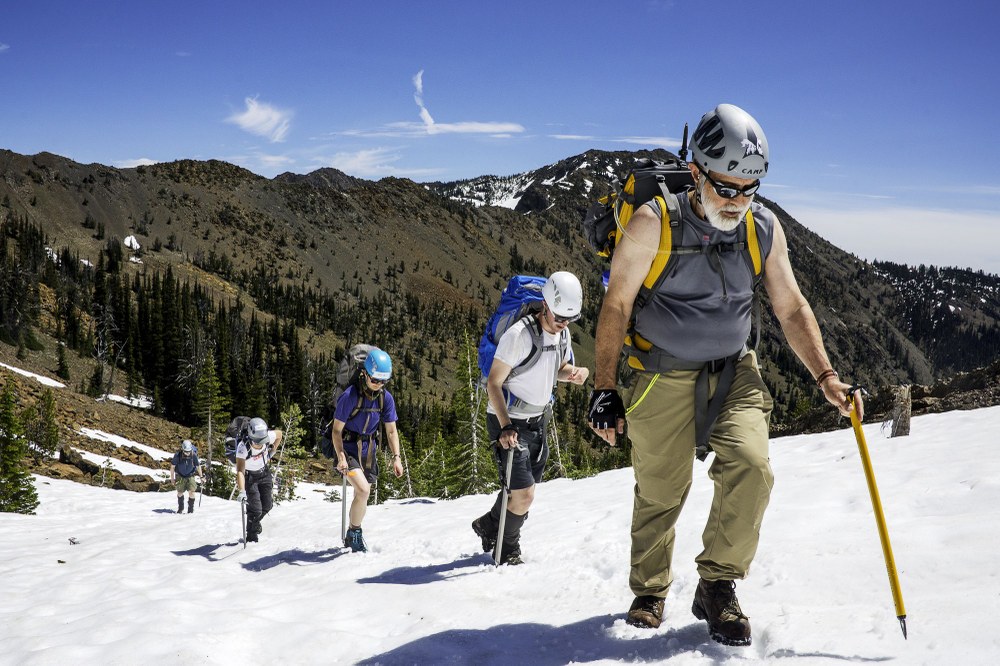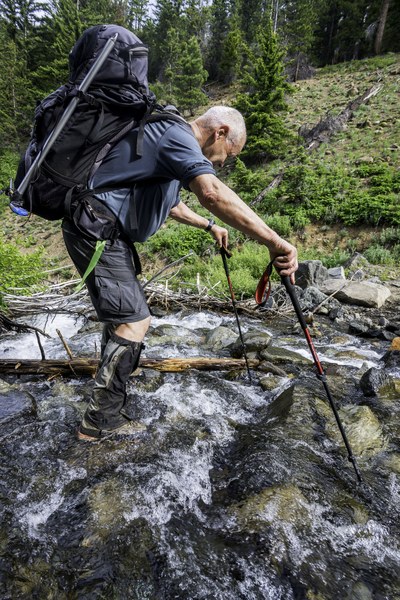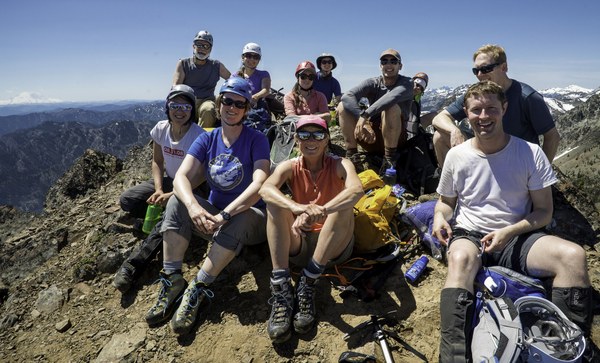
I looked around at the others, perhaps 75 in all, and saw that almost everyone was quite a bit younger than me. One exception was an instructor who looked like he might at least hail from the same part of the century. The lines on his clean-shaven face were well-defined and weathered in a good way.
Barely noticeable, a small paunch was his only outward concession to the years. Overall he looked very fit and sturdy. His high-end, knee-length gaiters — neatly attached to clean, well-maintained boots —reinforced the impression. Even though the sun hadn’t hit the clearing in the Bean Creek Basin in the Teanaway where we stood, he was wearing sunglasses. He walked over and, perhaps keying on my white beard and noticeable enough paunch, greeted me by asking, “How old are you?”
“66,” I answered. “And how old are you?”
“77,” he replied, and walked away.
What the heck? I thought. He’s 11 years older than me? I was a little bemused, but also kind of impressed. This was my introduction to the experience field trip segment of the compressed scrambling course. Walter, the 77-year-old instructor I’d just met, somehow intuited that age was on my mind.
A wannabe mountaineer
I’m a lifelong hiker and for longer than I care to admit, a wannabe mountaineer. I can remember the day in the winter of 1987-88 when I first wrote in to get brochures about climbing in the Cascades. The blue-tinted trifolds took up long-term residence on my simple pine coffee table, where they stood out against the grain. Since I’ve lived and worked most of my life on the East Coast, taking the next step and summiting these peaks was on hold until I retired from full-time government work. I saw my chance after my wife decided to go to acupuncture school in Mt. Vernon, Washington and started commuting to Washington for class one weekend a month.
One month I got a ticket to go with her. I went in search of the outfitter who had sent me the brochures. After pausing for a minute outside the no-frills storefront, I walked in and asked some very basic questions. Over the next three years, I embarked on a handful of short but intense summer climbing trips in the Cascades. The first year I failed to get up Mt. Baker because I was not fit enough. The second year I was fit enough to get close on Sahale Peak, but once I stepped onto the summit ridge from the Quien Sabe Glacier, I realized that I had a lot to learn about exposure. The third year, with a long-time friend and climbing partner, I made it to the top of Mt. Baker.
I was one unhappy climber when my partner decided to go back to full time work, and I was left to my own devices. But I was not ready to quit. On my 65th birthday, over morning coffee in our suburban DC kitchen, I joined both the Mazamas and The Mountaineers as a gift to myself. I immediately began looking for ways to get involved. I could at least be an armchair climber, and maybe figure out a way to take a course or two and meet like-minded climbers, form or join a cohort of some kind. Like my wife, the commuting acupuncture student, I could fly out West two to three times a year. Bottom line: by setting goals and challenging myself, I might stay fit for another ten years or so.
 Walter navigates a tricky stream crossing. Photo by Mike Warren.
Walter navigates a tricky stream crossing. Photo by Mike Warren.
And so, a year later, I signed up for the Compressed Scrambling Course.
Some of the people recently featured in Mountaineer magazine have overcome tremendous obstacles like brain surgery and addiction. My journey is hardly in the same category, but aging does have its challenges. Scrambling up a peak was my way of taking it on.
From wannabe to scrambler
From the start I was pleasantly surprised by the welcome I received. I must have seemed the strangest, neediest scrambling student — from the wrong coast and the wrong demographic, and with the most questions. Nevertheless, course chairman Jeff Patterson patiently answered email after email as I explained who I was and what I wanted to do. Jeff even offered to pick me up at the airport and let me sleep in his guest room — an expression of faith in the goodness of the outdoor community. How did he know I was not an ax murderer, a half-serious question that, believe it or not, my wife and I once fielded after a new hiking friend offered us a place to stay in Maine. When I finally got to the Seattle Program Center and met the other students, I felt at home.
Even though none of the other students had spent their lives toiling away in an airless federal building, and despite the fact that they collectively had more tattoos and colored hair than all the Feds in D.C. combined, they made me feel like I had been a part of the team for years. As different as we may have appeared on the surface, no one ever made me feel as though I was out of place.
This sense of community was one thing that set the course apart from commercial outdoor classes I’d taken in the past. Another major difference was that the instructors were all volunteers. One, Steve McClure, was even a board member who, I’ll wager, had to clear a busy schedule to be with us on a Friday afternoon. Most volunteer instructors were accomplished climbers and scramblers. When we caught a glimpse of Chris Spanton’s calendar as he was setting up a slideshow, we got an idea of what it means to be committed to mountaineering: his calendar looked a little like the schedule for the winter Olympics, with a variety of events every week.
The lessons we learned were reinforced over the course of three days. We began with in-town instruction, then spent the final two days at Stevens Pass, practicing what we learned in the classroom. A decent commercial class on self-arrest usually covers falling forward, head up, into the mountain. But in our course we ran through at least four scenarios, including one where we started on our backs, head down. As we practiced our instructor, Allison Swanson, cheerfully encouraged us in English and Danish. (“Why Danish?” you might ask, as I did. Answer: “Because the Portuguese class was overenrolled.”)
In case you haven’t experienced an upside-down self-arrest, you start out on your back in the snow on the mountainside. If you want, the instructor will grab hold of your boots as you get into position, and let go when you say you are ready, launching you downhill. You experience, in short order, a sense of disorientation from being upside down on a 35-45 degree slope — maybe even a hint of fear — then a moment of trust as you connect with the instructor, then a surge of adrenaline as you start to slide. Finally, assuming you manage to flip yourself over and plant your ice ax, relief and accomplishment.
The thoroughness of the course didn’t stop with self-arrest. Our prerequisites for graduation included completing three scrambles, a Wilderness First Aid course, and Navigation course – not to mention the experience field trip in the Teanaway a few weeks after the initial three-day course. I thought this was the right way to prepare future scramblers.
On the field trip, I chose to join one of the groups going for a lesser peak called Mary’s. I see now I could have pushed myself a good bit harder and gone for one of the more challenging peaks, but the upside was that Walter was one of our evaluators. I will not soon forget watching him tell students to do it again when their performance on a skill test wasn’t good enough — and then marking them honestly on the report cards we received. This was very different from courses where everyone passes more or less automatically.
I did well enough on the field trip to get one of the course’s custom-printed yellow alpine scrambling buffs, but in the end I didn’t get the scrambling badge itself. I completed the Navigation and First Aid courses back East, but it was tricky to schedule testing in Seattle, let alone work in three scrambles. Trying to bunch all the requirements up into manageable trips from the East Coast proved to be a bridge too far.
But I have no regrets. The course unfolded in stunningly beautiful corners of the Cascades I never would have found on my own. There I felt the camaraderie of the trail in small acts of support and friendship. I learned about scrambling, a discipline between technical mountaineering and hiking that provides folks with the skills to venture up breathtaking summits that lie off the beaten path.
A key point that I learned anew was the value of planning and preparation, especially for the older outdoorsman. A few decades ago, I could go on a six-day expedition with little preparation; now I need to ramp up my exercise routine before heading out, even if it’s just a challenging day hike. It may take a bit more diligence for me to get outside these days, but that doesn’t mean the adventure’s over. Thanks to Walter, I learned that you can keep going long after conventional wisdom tells you to lower your expectations and settle into a rocker on the porch.
 Summit smiles all around for Nick and the team. Photo by Mike Warren.
Summit smiles all around for Nick and the team. Photo by Mike Warren.
This article originally appeared in our Spring 2019 issue of Mountaineer Magazine. To view the original article in magazine form and read more stories from our publication, click here.
 Nicholas Reynolds
Nicholas Reynolds